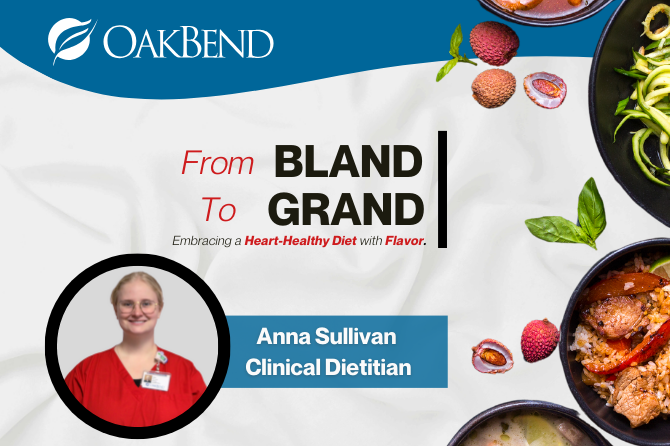
February marks a significant time for heart health awareness. As we wrap up the month, Anna Sullivan, our esteemed dietitian at OakBend Medical Center, shares her insights on transforming the perceived dull heart-healthy diet into a delicious adventure. “Many of my patients believe a heart-healthy diet restricts all the good foods, thinking it’s all bland and boring. I’m here to debunk that myth,” says Sullivan.
The Heart of Healthy Eating
A heart-healthy diet, as Anna explains, is one that’s low in sodium, saturated fats, and eliminates trans fats, but rich in high-fiber foods and unsaturated fats. But what does this mean in simpler terms?
“Saturated fats are what I call the ‘bad fats’,” Sullivan notes. These fats, solid at room temperature, are found in animal products and certain oils, contributing to plaque buildup in the veins. On the other hand, unsaturated fats, the ‘good fats,’ are essential, especially omega-3 fatty acids, which combat inflammation and support overall heart health.
Making the Shift: Practical Tips from Anna Sullivan
Anna shares tangible steps to incorporate heart-healthy choices into daily meals without sacrificing flavor:
Lean into Lean Meats
“Opt for lean meats like chicken, turkey, and pork, trimming away visible fats. When choosing ground meat, select options that are 95% lean protein or higher,” advises Sullivan. This simple change significantly reduces saturated fat intake, aligning with heart-healthy guidelines.
Embrace the World of Whole Grains and Fiber
“Whole grains are your best friend in a heart-healthy diet,” Sullivan states. She encourages choosing brown rice, quinoa, and whole wheat bread over refined grains. These not only provide necessary nutrients but also help manage cholesterol levels.
Reduce Sodium, Not Flavor
Anna warns about the hidden sodium in processed foods and suggests, “Look for products with less than 200 mg of sodium per serving. And remember, cooking at home allows you to control the amount of salt added to your dishes.”
Creative Cooking Techniques
“Healthy cooking doesn’t mean you have to give up on taste,” Sullivan assures. She suggests baking, grilling, steaming, and using herbs and spices instead of relying heavily on salt for flavoring. “Incorporate a variety of spices to add flavor without the added sodium.”
Sweeten Smartly
“To reduce sugar intake, use natural sweeteners like applesauce, honey, or agave in recipes. These alternatives provide the sweetness you crave, without the empty calories,” Anna recommends.
Anna Sullivan’s Closing Thoughts
A heart-healthy diet is not about restriction but about making smarter choices that benefit your heart and overall well-being. Anna Sullivan reminds us, “It’s about balance and making informed decisions that add both nutrition and joy to your meals.”
With Anna’s expert advice, we’re reminded that a heart-healthy diet can indeed be both nutritious and delicious. Her practical tips serve as a guide for anyone looking to improve their heart health through diet. At OakBend Medical Center, we’re committed to providing you with the resources and support you need to live a healthier, happier life.
Call our Nutrition Department at 281-341-4817 to schedule an appointment with one of our expert dietitians, including Anna Sullivan. For more resources and information, visit our Food and Nutrition page at https://oakbendmedcenter.org/food-nutrition/.
Leave a reply







